COVID-19: Business Innovation Challenges
Abstract
1. Introduction
- −
- Has the COVID-19 pandemic caused a crisis in all industries (sections of the economy)?
- −
- Was the occurrence of a pandemic-related crisis linked to the size of the enterprise?
- −
- Did the introduction of product, process, marketing, organisational, and management innovations depend on the size of the business and industry?
- −
- Did the introduction of innovations depend on whether or not a business went through a crisis?
- −
- How did businesses respond to crises?
- −
- Did they introduce management innovations?
2. Innovation during the COVID-19 Pandemic—A Literature Review
2.1. Implications of the COVID-19 Pandemic for Economies, Societies, and Enterprises
2.2. Business Reaction to the COVID-19 Crisis
2.3. Innovation—A Response to a Crisis
2.4. Research Hypotheses
3. Materials and Methods
3.1. Population
3.2. Measurement
4. Results
4.1. Analysis and Results
4.2. Verification of the Hypotheses
5. Discussion
6. Conclusions
Funding
Institutional Review Board Statement
Informed Consent Statement
Data Availability Statement
Conflicts of Interest
References
- Ding, W.; Li, S. National response strategies and marketing innovations during the COVID19 pandemic. Bus. Horiz. 2021, 64, 295–306. [Google Scholar] [CrossRef] [PubMed]
- Wang, R.; Ma, S.; Xu, X.; Song, P. Heterogeneous Shareholders’ Participation, COVID-19 Impact, and Innovation Decisions of State-Owned Firms: Evidence from China. Sustainability 2021, 13, 4406. [Google Scholar] [CrossRef]
- Czarnitzki, D.; Hussinger, K. The link between R&D subsidies, R&D spending and technological performance. ZEW Discuss. Pap. 2004, 04-56, 1–26. Available online: http://hdl.handle.net/10419/24065 (accessed on 30 September 2021).
- Balsmeier, B.; Fleming, L.; Manso, G. Independent boards and innovation. J. Financ. Econ. 2017, 123, 536–557. [Google Scholar] [CrossRef]
- Manso, G. Motivating innovation. J. Financ. 2011, 66, 1823–1860. [Google Scholar] [CrossRef]
- Luong, H.; Moshirian, F.; Nguyen, L.; Tian, X.; Zhang, B. How do foreign institutional investors enhance firm innovation? J. Financ. Quant. Anal. 2017, 52, 1449–1490. [Google Scholar] [CrossRef]
- Roper, S.; Turner, J. R&D and innovation after COVID-19: What can we expect? A review of prior research and data trends after the great financial crisis. Int. Small Bus. J. 2020, 38, 504–514. [Google Scholar] [CrossRef]
- Gadzała, Ł. Koronawirus Pojawił Się Na Świecie Już W Listopadzie? 2020. Available online: https://www.euractiv.pl/section/bezpieczenstwo-i-obrona/news/koronawirus-pojawil-sie-na-swiecie-juz-w-listopadzie/ (accessed on 21 July 2021).
- Cowling, M.; Brown, R.; Rocha, A. Did you save some cash for a rainy COVID-19 day? The crisis and SMEs Marc Cowling University of Derby. Int. Small Bus. J. Res. Entrep. 2020, 38, 593–604. [Google Scholar] [CrossRef]
- Rowan, N.J.; Galanakis, C.M. Unlocking challenges and opportunities presented by COVID-19 pandemic for cross-cutting disruption in agri-food and green deal innovations: Quo Vadis? Sci. Total Environ. 2020, 748, 141362. [Google Scholar] [CrossRef] [PubMed]
- Iavicoli, S.; Boccuni, F.; Buresti, G.; Gagliardi, D.; Persechino, B.; Valenti, A.; Rondinone, B.M. Risk assessment at work and prevention strategies on COVID-19 in Italy. PLoS ONE 2021, 16, e0248874. [Google Scholar] [CrossRef]
- Mączyńska, E. Czym Jest “Czarny Łabędź”? 2020. Available online: https://gazeta.sgh.waw.pl/?q=po-prostu-ekonomia/czym-jest-czarny-labedz (accessed on 15 August 2021).
- Mielech, P. Teoria Czarnego Łabędzia—Czym Jest Czarny Łabędź i Dlaczego Inwestorzy Powinni Się Go Obawiać? 2020. Available online: https://www.lynxbroker.pl/edukacja/teoria-czarnego-labedzia/ (accessed on 15 August 2021).
- Beck, K.; Janus, J. Podobieństwo wstrząsów podażowych i popytowych w Polsce i innych krajach Unii Europejskiej. Ekonomista 2016, 1, 112–140. Available online: http://www.ekonomista.info.pl/ (accessed on 16 August 2021).
- Taleb, N.N.; Czarny Łabędź. Jak Nieprzewidywalne Zdarzenia Rządzą Naszym Życiem. Wydawnictwo Zysk i Ska. 2020. Available online: https://docer.pl/doc/s150100 (accessed on 20 August 2021).
- Rowan, N.; Laffey, J.G. Challenges and solutions for addressing critical shortage of supply chain for personal and protective equipment (PPE) arising from Coronavirus disease (COVID19) pandemic—Case study from the Republic of Ireland. Sci. Total Environ. 2020, 725, 138532. [Google Scholar] [CrossRef] [PubMed]
- Guan, D.; Wang, D.; Hallegatte, S.; Davis, S.J.; Huo, J.; Li, S.; Bai, Y.; Lei, T.; Xue, Q.; Coffman, D.M.; et al. Global supply-chain effects of COVID-19 control measures. Nat. Hum. Behav. 2020, 4, 577–587. [Google Scholar] [CrossRef] [PubMed]
- Reid, G.; O’Beirne, N.; Gibson, N. How Companies Can Reshape Results and Plan for a COVID-19 Recovery. 2020. Available online: https://www.ey.com/en_ie/transactions/companies-can-reshape-results-and-plan-for-covid-19-recovery (accessed on 6 June 2021).
- Raies, A.; Mimoun, M.B. Laying Off Versus Training Workers: How Can Saudi Entrepreneurs Manage the COVID-19 Crisis? J. Asian Financ. Econ. Bus. 2021, 8, 673–685. [Google Scholar] [CrossRef]
- Ebata, A.; Nisbett, N.; Gillespie, S. Food systems after Covid-19. IDS Bull. 2021, 52, 73–94. Available online: https://bulletin.ids.ac.uk/index.php/idsbo/article/view/3118 (accessed on 20 August 2021). [CrossRef]
- Lepore, D.; Micozzi, A.; Spigarelli, F. Industry 4.0 Accelerating Sustainable Manufacturing in the COVID-19 Era: Assessing the Readiness and Responsiveness of Italian Regions. Sustainability 2021, 13, 2670. [Google Scholar] [CrossRef]
- Kumar, A.; Luthra, S.; Mangla, S.K.; Kazançoğlu, Y. COVID-19 impact on sustainable production and operations management. Sustain. Oper. Comput. 2020, 1, 1–7. [Google Scholar] [CrossRef]
- Degli Esposti, P.; Mortara, A.; Roberti, G. Sharing and Sustainable Consumption in the Era of COVID-19. Sustainability 2021, 13, 1903. [Google Scholar] [CrossRef]
- Albaz, A.; Mansour, T.; Rida, T.; Schubert, J. Setting up small and medium-size enterprises for restart and recovery. Public Soc. Sect. Insights McKinsey Co. 2020, 9. Available online: https://www.mckinsey.com/industries/public-and-social-sector/our-insights/setting-up-small-and-medium-size-enterprises-for-restart-and-recovery (accessed on 10 August 2021).
- Korsgaard, S.; Hunt, R.A.; Townsend, D.M.; Ingstrup, M.B. COVID-19 and the importance of space in entrepreneurship research and policy. Int. Small Bus. J. 2020, 38, 697–710. [Google Scholar] [CrossRef]
- Li, Z.; Anaba, O.A.; Ma, Z.; Li, M. Ghanaian SMEs Amidst the COVID-19 Pandemic: Evaluating the Influence of Entrepreneurial Orientation. Sustainability 2021, 13, 1131. [Google Scholar] [CrossRef]
- Danilin, I.V. The Impact of the COVID Crisis on the Innovative Potential of China’s Internet Platforms. Her Russ Acad. Sci. 2020, 90, 779–788. [Google Scholar] [CrossRef] [PubMed]
- Habiyaremye, A. Co-Operative Learning and Resilience to COVID-19 in a Small-Sized South African Enterprise. Sustainability 2021, 13, 1976. [Google Scholar] [CrossRef]
- Thukral, E. COVID-19: Small and medium enterprises challenges and responses with creativity, innovation, and entrepreneurship. Strateg. Chang. 2021, 30, 153–158. [Google Scholar] [CrossRef]
- Ratten, V. Coronavirus and international business: An entrepreneurial ecosystem perspective. Thunderbird Int. Bus. Rev. 2020, 62, 629–634. [Google Scholar] [CrossRef]
- Schumpeter, J.A. Teoria Rozwoju Gospodarczego; PWN: Warszawa, Poland, 1960. [Google Scholar]
- Drucker, P.F. Innowacja i Przedsiębiorczość. Praktyka i Zasady; PWE: Warszawa, Poland, 1992. [Google Scholar]
- Kotler, P. Marketing. Analiza, Planowanie, Wdrażanie i Kontrola; Wydawnictwo Gebethner i S-ka: Warszawa, Poland, 1994. [Google Scholar]
- Sambrook, S.A.; Baregheh, A.; Rowley, J.; Sambrook, S. Towards a multidisciplinary definition of innovation. Manag. Decis. 2009, 8, 1323–1339. [Google Scholar] [CrossRef]
- Zahra, S.A.; Covin, J.G. The financial implications of fit between competitive strategy and innovation types and sources. J. High Technol. Manag. Res. 1994, 2, 183–211. [Google Scholar] [CrossRef]
- Javaid, M.; Haleem, A.; Vaishya, R.; Bahl, S.; Suman, R.; Vaish, A. Industry 4.0 technologies and their applications in fighting COVID-19 pandemic. Diabetes Metab. Syndr. Clin. Res. Rev. 2020, 14, 419–422. [Google Scholar] [CrossRef] [PubMed]
- Sarfraz, Z.; Sarfraz, A.; Iftikar, H.M.; Akhund, R. Is COVID-19 pushing us to the Fifth Industrial Revolution (Society 5.0)? Pak. J. Med. Sci. 2021, 37, 591–594. [Google Scholar] [CrossRef] [PubMed]
- Tiwari, R.; Buse, S.; Herstatt, C. Innovation via Global Route: Proposing a Reference Model for Chances and Challenges of Global Innovation Processes. TIM/TUHH Work. Pap. 2007, 49, 1–19. Available online: http://www.global-innovation.net/publications/PDF/Working_Paper_49.pdf (accessed on 22 August 2021).
- Hamel, G.; Prahalad, C.K. Thinking Differently. Bus. Q. 2002, 59, 22–35. [Google Scholar]
- Hamel, G. Innowacje w sferze zarządzania: Powody, cele i sposoby. HBR 2006, 38, 57–68. [Google Scholar]
- Birkinshaw, J.; Hamel, G.; Mol, M.J. Management Innovation. Acad. Manag. Rev. 2008, 4, 825–845. [Google Scholar] [CrossRef]
- Vaccaro, I.G.; Jansen, J.J.P.; Van Den Bosch, F.A.J.; Volberda, H.W. Management Innovation and Leadership: The Moderating Role of Organizational Size. J. Manag. Stud. 2012, 49, 28–51. [Google Scholar] [CrossRef]
- Mothe, C.; Thi, T.U.N. The link between non-technological innovations and technological innovation. Eur. J. Innov. Manag. 2010, 13, 313–332. [Google Scholar] [CrossRef]
- Nonaka, I.; Takeuchi, H. Kreowanie Wiedzy w Organizacji; Poltext: Warszawa, Poland, 2000. [Google Scholar]
- Nakagaki, P.; Aber, J.; Fetterhoff, T. The Challenges in Implementing Open Innovation in a Global Innovation-Driven Corporation. Res. Technol. Manag. 2012, 55, 32–38. [Google Scholar] [CrossRef]
- Spławski, P.; Patorska, J.; Kurtek, M. Koronawirus: Niemal Sześć Na Dziesięć Polskich Firm Odczuło Negatywny Wpływ Epidemii. 2020. Available online: https://alebank.pl/koronawirus-niemal-szesc-na-dziesiec-polskich-firm-odczulo-negatywny-wplyw-epidemii/ (accessed on 22 August 2021).
- Zeschky, M.; Widenmayer, B.; Gassmann, O. Frugal Innovation in Emerging Markets. Res.-Technol. Manag. 2011, 54, 38–45. [Google Scholar] [CrossRef]
- Saviotti, P.P.; Pyka, A. Innovation, structural change and demand evolution: Does demand saturate? J. Evol. Econ. 2017, 27, 337–358. [Google Scholar] [CrossRef]
- Włodarczyk, K. Virtualization of consumption in Polish society. Res. Pap. Wrocław Univ. Econ. 2015, 414, 237–249. [Google Scholar] [CrossRef][Green Version]
- Karpińska, K.; Matel, A.; Protasiewicz, A. Konsument w działalności innowacyjnej przedsiębiorstw. Pol. Tow. Ekon. Oddział W Białymstoku Białystok 2017. [Google Scholar] [CrossRef]
- Witkowski, J.; Pisarek, A. Istota zielonych łańcuchów dostaw—Propozycja systematyzacji pojęć. Studia Ekon. Zesz. Nauk. Uniw. Ekon. W Katowicach 2017, 315, 11–26. [Google Scholar]
- Beamon, B.M. Designing the Greeen Supply Chain. Logist. Inf. Manag. 1999, 12, 332–342. [Google Scholar] [CrossRef]
- Srivastave, S.K. Green Supply Chain Management: A State-of-the-Art Literature Review. Int. J. Manag. Rev. 2007, 9, 53–80. [Google Scholar] [CrossRef]
- Hanggraeni, D.; Sinamo, T. Quality of Entrepreneurship and Micro-, Small- and medium-sized Enterprises’ (MSMEs) Financial Performance in Indonesia. J. Asian Financ. Econ. Bus. 2021, 8, 0897–0907. [Google Scholar] [CrossRef]
- Isik, C.; Aydin, E.; Dogru, T.; Rehman, A.; Alvarado, R.; Ahmad, M.; Irfan, M. The Nexus between Team Culture, Innovative Work Behaviour and Tacit Knowledge Sharing: Theory and Evidence. Sustainability 2021, 13, 4333. [Google Scholar] [CrossRef]
- Muñoz-Pascual, L.; Galende, J.; Curado, C. Contributions to Sustainability in SMEs: Human Resources, Sustainable Product Innovation Performance and the Mediating Role of Employee Creativity. Sustainability 2021, 13, 2008. [Google Scholar] [CrossRef]
- Podręcznik Oslo. OECD. 2005. Available online: http://home.agh.edu.pl/~kkulak/lib/exe/fetch.php?media=user:konrad:vary:oslo-manual.pdf (accessed on 15 October 2021).
- Barańska-Fischer, M. Innowacje produktowe odzwierciedleniem rynkowej orientacji organizacji. Zesz. Nauk. Uniw. Ekon. W Pozn. 2010, 153, 194–201. [Google Scholar]
- Sadowska-Bień, J. Innowacje procesowe w przedsiębiorstwie—Wpływ wdrożenia na środowisko naturalne. Prace Mater. Wydziału Zarządzania Uniw. Gdańskiego 2004, 2, 199–211. [Google Scholar]
- Sławińska, M. Innowacje marketingowe w działalności przedsiębiorstw handlowych. Ann. Univ. Mariae Curie—Skłodowska 2015, 1, 157–167. [Google Scholar]
- Czekaj, J. Metody Organizatorskie W Doskonaleniu Systemu Zarządzania; Wydawnictwo, WNT: Warszawa, Poland, 2013. [Google Scholar]
- Lichtarski, J.M. Innowacje w obszarze struktur organizacyjnych przedsiębiorstw i jednostek sektora publicznego. Pr. Nauk. Akad. Ekon. W Katowicach 2010, 373–380. [Google Scholar]
- Baran, G. Potrzeba innowacji zarządzania: Czy współtworzenie wartości wraz z klientami oznacza początek „zarządzania 2.0”? Zarządzanie Publiczne 2012, 1, 11–25. [Google Scholar]
- Hamel, G. The why, what, and how of management innovation. Harv. Bus. Rev. 2006, 84, 72–84. [Google Scholar] [PubMed]
- Hamel, G.; Breen, B. Zarządzanie Jutra. Jakie Jest Twoje Miejsce W Przyszłości? Harvard Business School Press; Wydawnictwo, Red Horse: Lublin, Poland, 2008. [Google Scholar]
- Kraśnicka, T.; Głód, W.; Wronka, M. Pojęcie, determinanty i znaczenie innowacji zarządczych (management innovation)—Stan badań nad zjawiskiem. Zesz. Nauk. Politech. Śląskiej. Ser. Organ. Zarządzanie 2014, 73, 333–349. [Google Scholar]
- Likert, R. A technique for the measurement of attitudes. Arch. Psychol. 1932, 140, 5–55. [Google Scholar]
- Tarka, P. Własności 5-I-7-stopniowej skali Likerta w kontekście normalizacji zmiennych metodą Kaufmana i Rousseeuwa. Pr. Nauk. Uniw. Ekon. We Wrocławiu 2015, 207, 286–295. [Google Scholar] [CrossRef]
- Chilko, D.; Dowdy, S.; Wearden, S. Statistics for Research; Willey-Interscience: Hoboken, NJ, USA, 2004. [Google Scholar]
- Aczel, A.D.; Sounderpandian, J. Statystyka w Zarządzaniu; Wydawnictwo Naukowe PWN: Warszawa, Poland, 2018. [Google Scholar]
- Słowińska, M. Wykorzystanie testu Chi-kwadrat w badaniach preferencji żywieniowych konsumentów. Nauk. Inżynierskie Technol. 2019, 1, 24–38. [Google Scholar] [CrossRef]
- Męcina, J.; Potocki, P. Wpływ COVID 19 na gospodarkę i rynek pracy w Polsce—Wyciąg z raportu badawczego. Ekspertyza 2020, 11. [Google Scholar] [CrossRef]
- Dzierżanowski, M. Raport Biznes w Erze COVID-19. Pokonać Lęk Przed Zmianą. My Company Polska. 2021. Available online: https://mycompanypolska.pl/artykul/raport-biznes-w-erze-covid-19-pokonac-lek-przed-zmiana-%5Bwywiad%5D/5860 (accessed on 14 August 2021).
- Gehrke-Gut, H. Czy Kryzys Dotknie Branżę Marketingu, Public Relations i Reklamy? Rekl. Mark. 2020, 9. Available online: http://gazeta-msp.pl/?id=pokaz_artykul&indeks_artykulu=4728 (accessed on 15 October 2021).
- Kubera, G. Raport Biznes w Erze COVID-19. Koronawirus Uderzył W Polską Gospodarkę. My Company Polska. 2021. Available online: https://mycompanypolska.pl/artykul/raport-biznes-w-erze-covid-10-koronawirus-uderzyl-w-polska-gospodarke/5836 (accessed on 15 October 2021).
- Bettman, D.; Blikle, A.J.; Bochniarz, H.; Brzostowski, T.; Budziak, T.; Eichelberger, W.; Erdman, J.; Grzesiak, J.; Hausner, J.; Łabno-Falęckaad, E.; et al. RAPORT BIZNES Co Dalej w Biznesie? Jak Pandemia Zmieniła Zarządzanie Firmami i Ludźmi. Fundacja GAP. Available online: https://oees.pl/wp-content/uploads/2021/01/raport_biznes_nowy.pdf (accessed on 15 October 2021).
- Monitoring Trendów W Innowacyjności Jest Cyklicznym Raportem Przygotowywanym Przez Departament Analiz I Strategii PARP W Ramach Projektu Inno_LAB. Publikacja Jest Finansowana Z Funduszy Europejskich W Ramach Programu Operacyjnego Inteligentny Rozwój. Available online: https://www.parp.gov.pl/component/content/article/62819:parp-innowacyjnosc-kluczem-do-wyjscia-z-kryzysu (accessed on 15 October 2021).
- Innowacyjność Najlepszym Sposobem Na Pokonanie Kryzysu. Available online: https://www.wnp.pl/tech/innowacyjnosc-najlepszym-sposobem-na-pokonanie-kryzysu,178513.html (accessed on 20 August 2021).
- Babina, T.; Bernstein, A.; Mezzanotti, F. Crisis Innovation (Listopad 2020). SSRN. Available online: https://ssrn.com/abstract=3567425 (accessed on 20 August 2021).
- Ode, E.; Ayavoo, R. The mediating role of knowledge application in the relationship between knowledge management practices and firm innovation. J. Innov. Knowl. 2020, 5, 210–218. [Google Scholar] [CrossRef]
- Hameed, W.U.; Nisar, Q.A.; Wu, H.C. Relationships between external knowledge, internal innovation, firms’ open innovation performance, service innovation and business performance in the Pakistani hotel industry. Int. J. Hosp. Manag. 2021, 92, 102745. [Google Scholar] [CrossRef]
- Costa, V.; Monteiro, S. Key knowledge management processes for innovation: A systematic literature review. VINE J. Inf. Knowl. Manag. Systems 2016, 46, 386–410. [Google Scholar] [CrossRef]
- Donate, M.; Pablo, J.S. The role of knowledge-oriented leadership in knowledge management practices and innovation. J. Bus. Res. 2015, 68, 360–370. [Google Scholar] [CrossRef]
- Mardani, A.; Nikoosokhan, S.; Moradi, M.; Doustar, M. The relationship between knowledge management and innovation performance. J. High Technol. Manag. Res. 2018, 29, 12–26. [Google Scholar] [CrossRef]
- Burzyńska, M. Droga Do Innowacji a COVID-19 Wyzwania Dla CEO. Available online: https://www.ayming.pl/wp-content/uploads/sites/16/2020/06/Droga-do-innowacji.-Wyzwania-CEO_raport.pdf (accessed on 15 October 2021).
- Bitner, T. Pandemia Może Tylko Pobudzić Innowacje. Available online: https://www.digitalexcellence.pl/hub/pandemia-i-innowacje (accessed on 15 October 2021).
- Gorzelany-Dziadkowiec, M.; Gorzelany, J.; Gaisch, M. A Comparison of Innovations in Management in Austrian and Polish Universities. Business and Non-profit Organizations Facing Increased Competition and Growing Customers’ Demands; Nalepka, A., Ujwary-Gil., A., Eds.; Foundation for the Dissemination of Knowledge and Science “Cognitione”: Nowy Targ, Poland; National-Louis University: Nowy Sącz, Poland, 2018; pp. 181–199. Available online: http://konferencja.jemi.edu.pl/files/monografia_vol17.pdf (accessed on 15 October 2021).
- Gorzelany-Dziadkowiec, M.; Gorzelany, J.; Stauskis, G.; Hernik, J.; Van Assche, K.; Noszczyk, T. The innovation process in local development—The material, institutional, and intellectual infrastructure shaping and shaped by innovation. Technol. Econ. Dev. Econ. 2019, 25, 1232–1258. [Google Scholar] [CrossRef]
- Annunziata, M.; Bourgeois, H. The Future of Work: How G20 Countries Can Leverage Digital-Industrial Innovations into Stronger High-Quality Jobs Growth. Discussion Paper 2018. Available online: http://www.economics-ejournal.org/economics/discussionpapers/2018-28 (accessed on 15 August 2021).
- Schiavi, G.S.; Behr, A. Universidade Federal do Rio Grande do Sul, Brasil Emerging technologies and new business models: A review on disruptive business models. Innov. Manag. Rev. 2018, 15, 338–355. [Google Scholar] [CrossRef]
- Burns, J.M. Transformational Leadership. Available online: http://www.langston.edu/sites/default/files/basic-content-files/TransformationalLeadership.pdf (accessed on 1 August 2021).
- Downey, J. Innovation Management; Topic Gateway Series; CIMA: London, UK, 2007; No. 38; Available online: http://www.cimaglobal.com/Documents/ImportedDocuments/cid_tg_innovation_management_jul07.pdf.pdf (accessed on 26 June 2021).
- Skerlavaj, M.; Hong-Song, J.H.; Lee, Y. Organizational learning culture, innovative culture and innovations in South Korean firms. Expert Syst. Appl. 2010, 37, 6390–6393. [Google Scholar] [CrossRef]
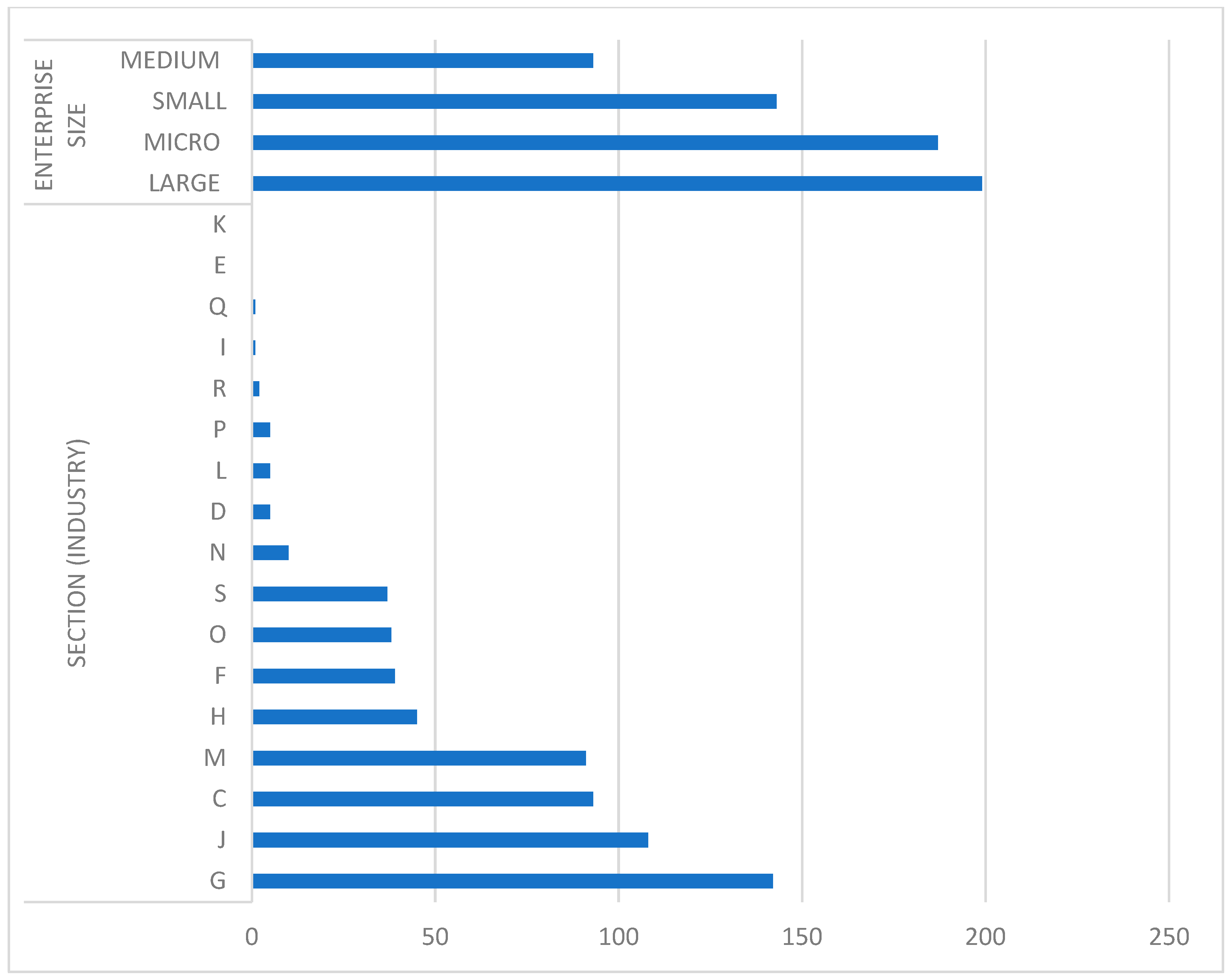
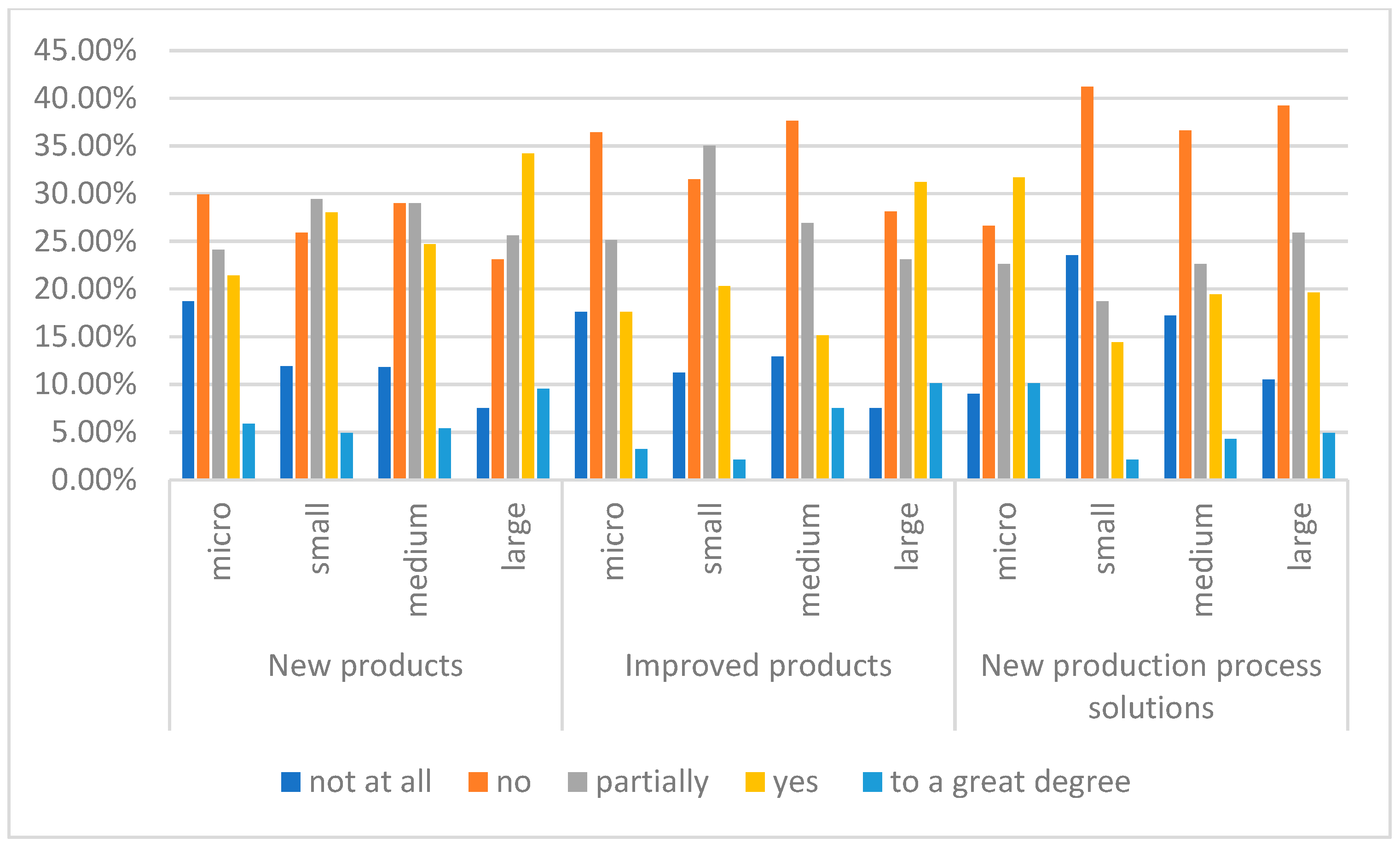
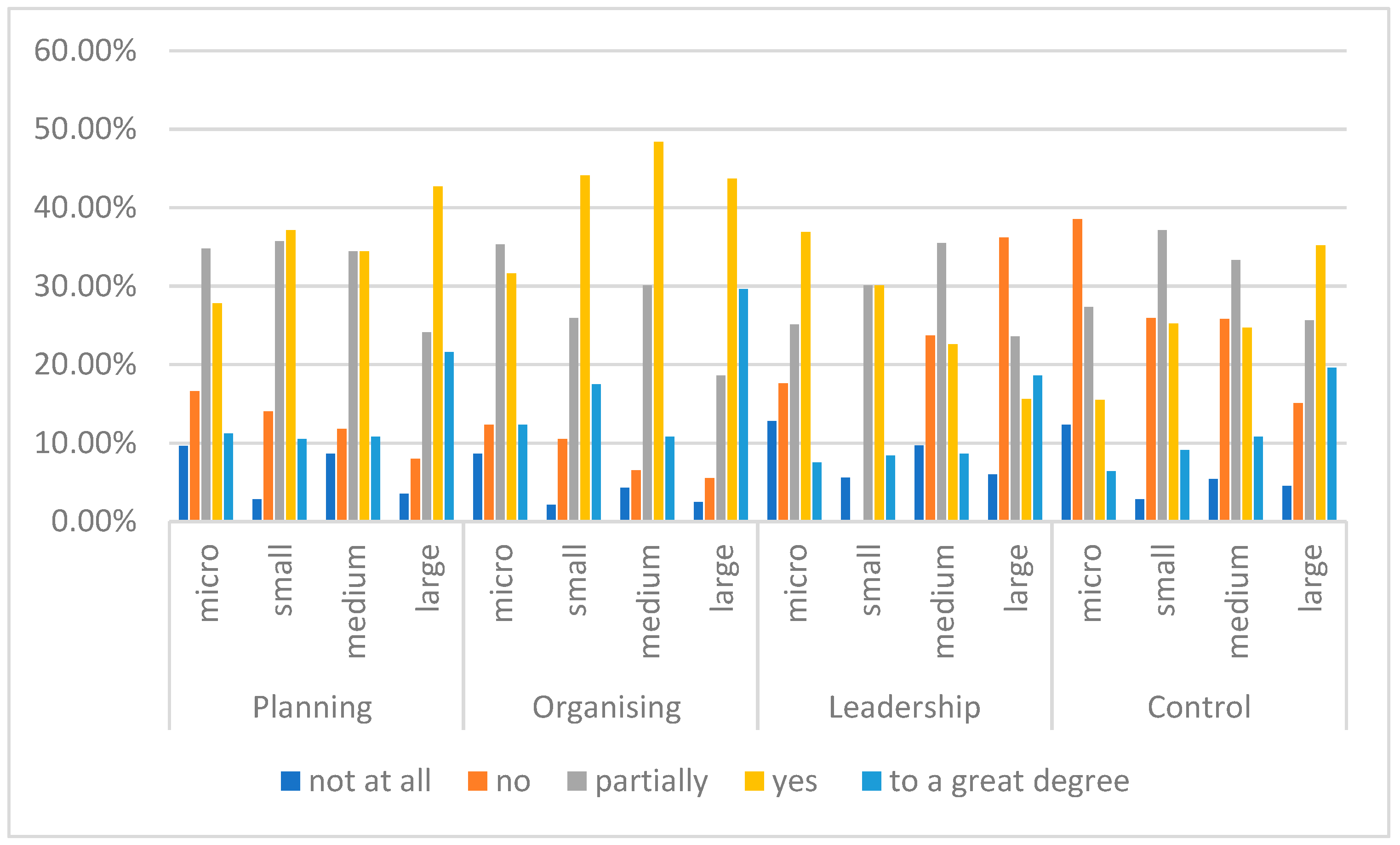
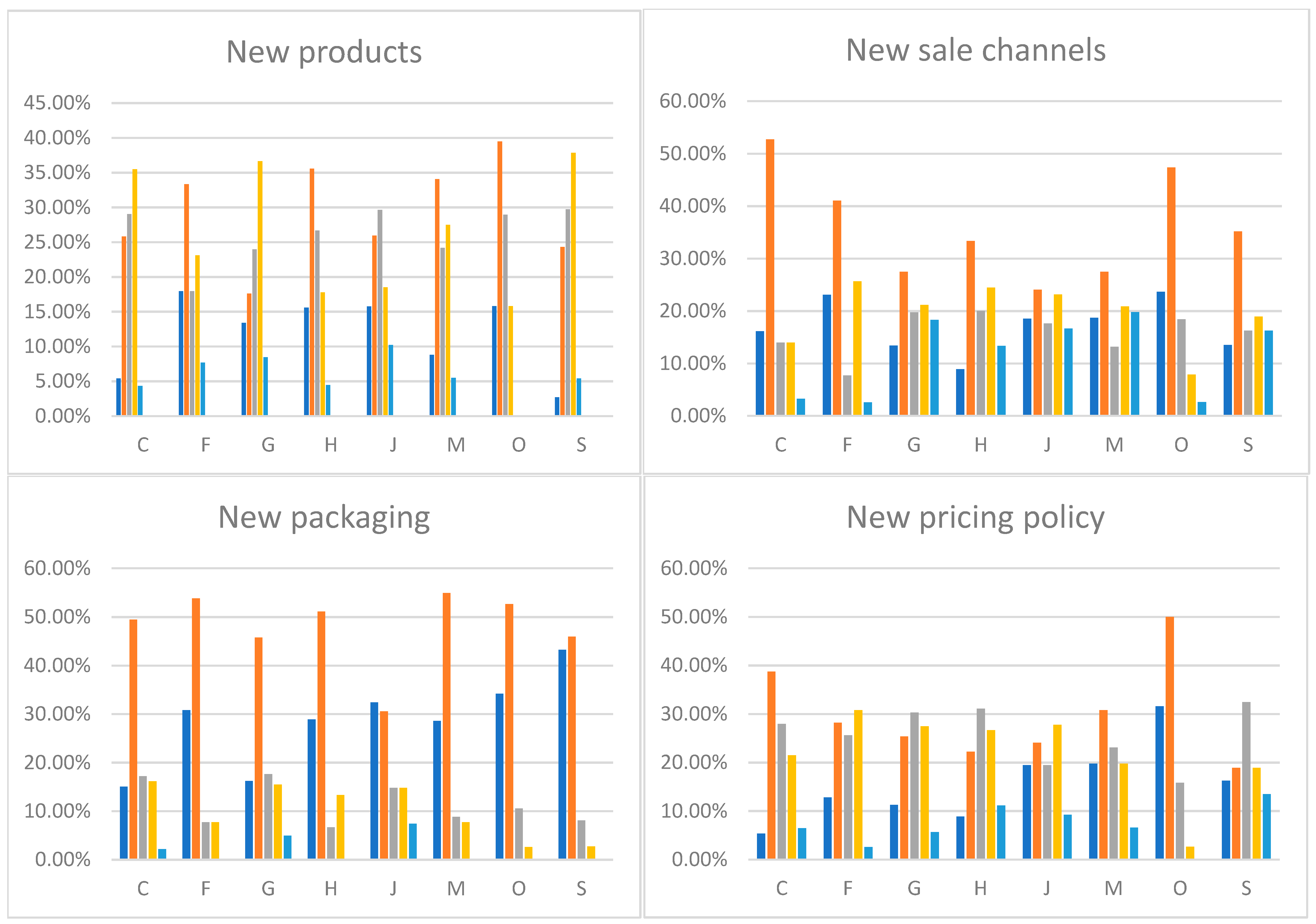
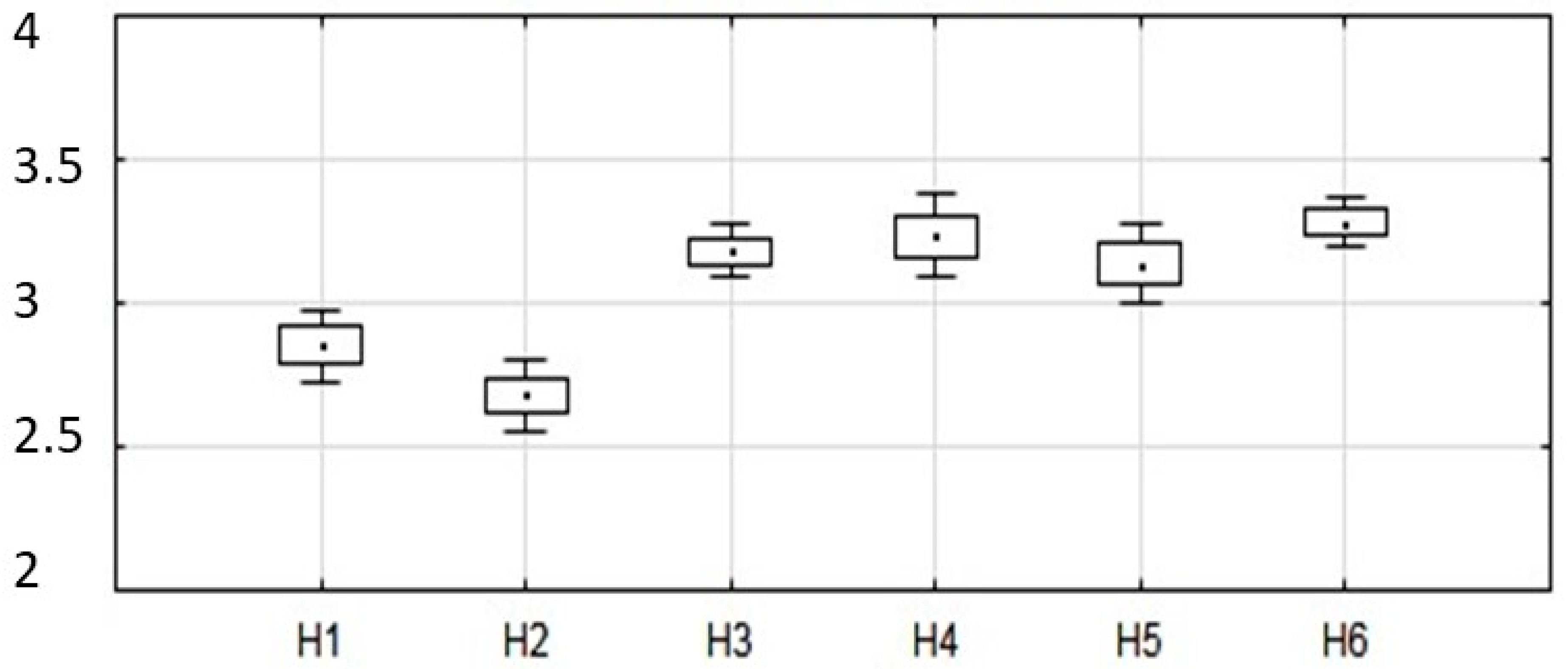
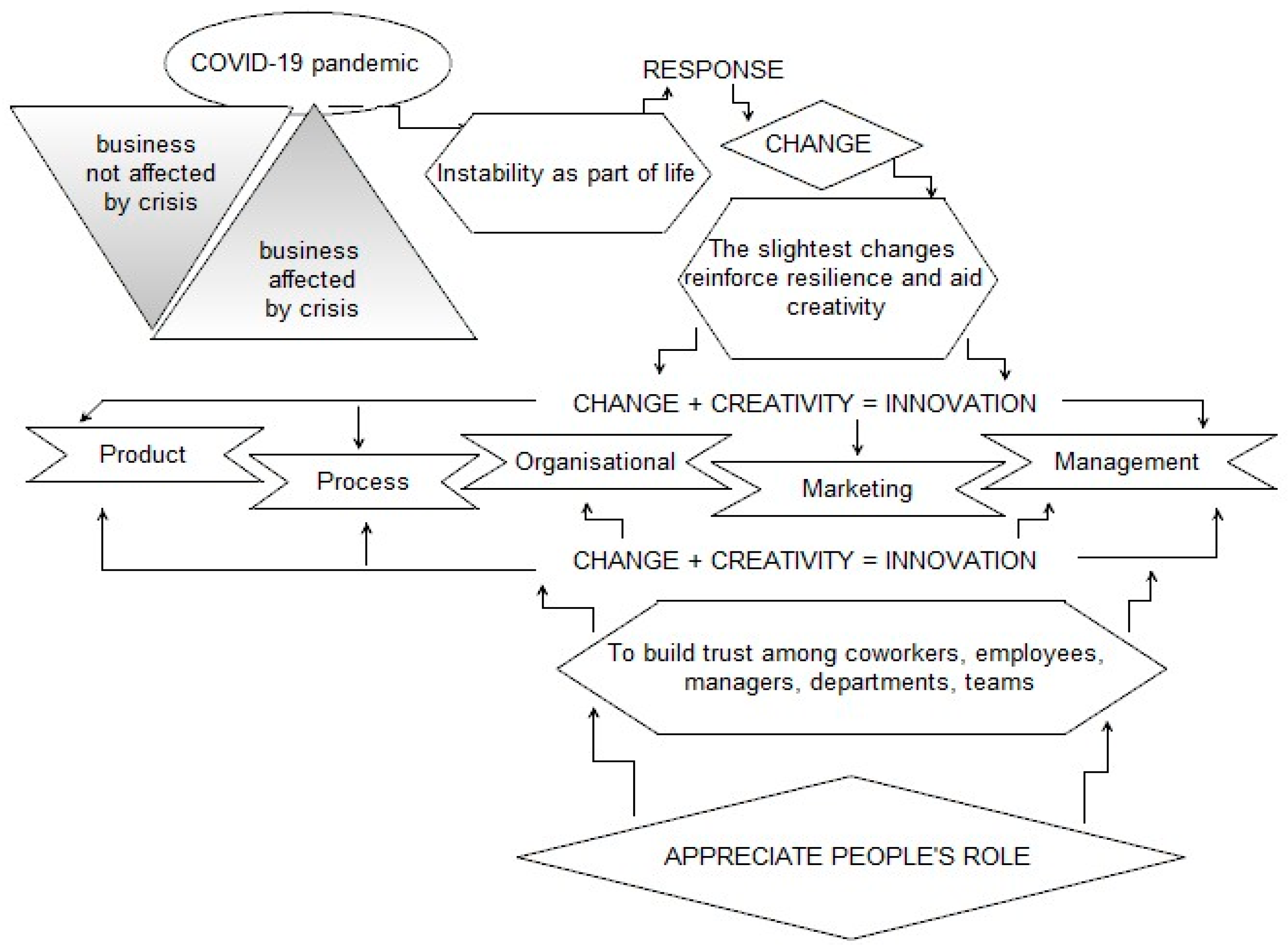
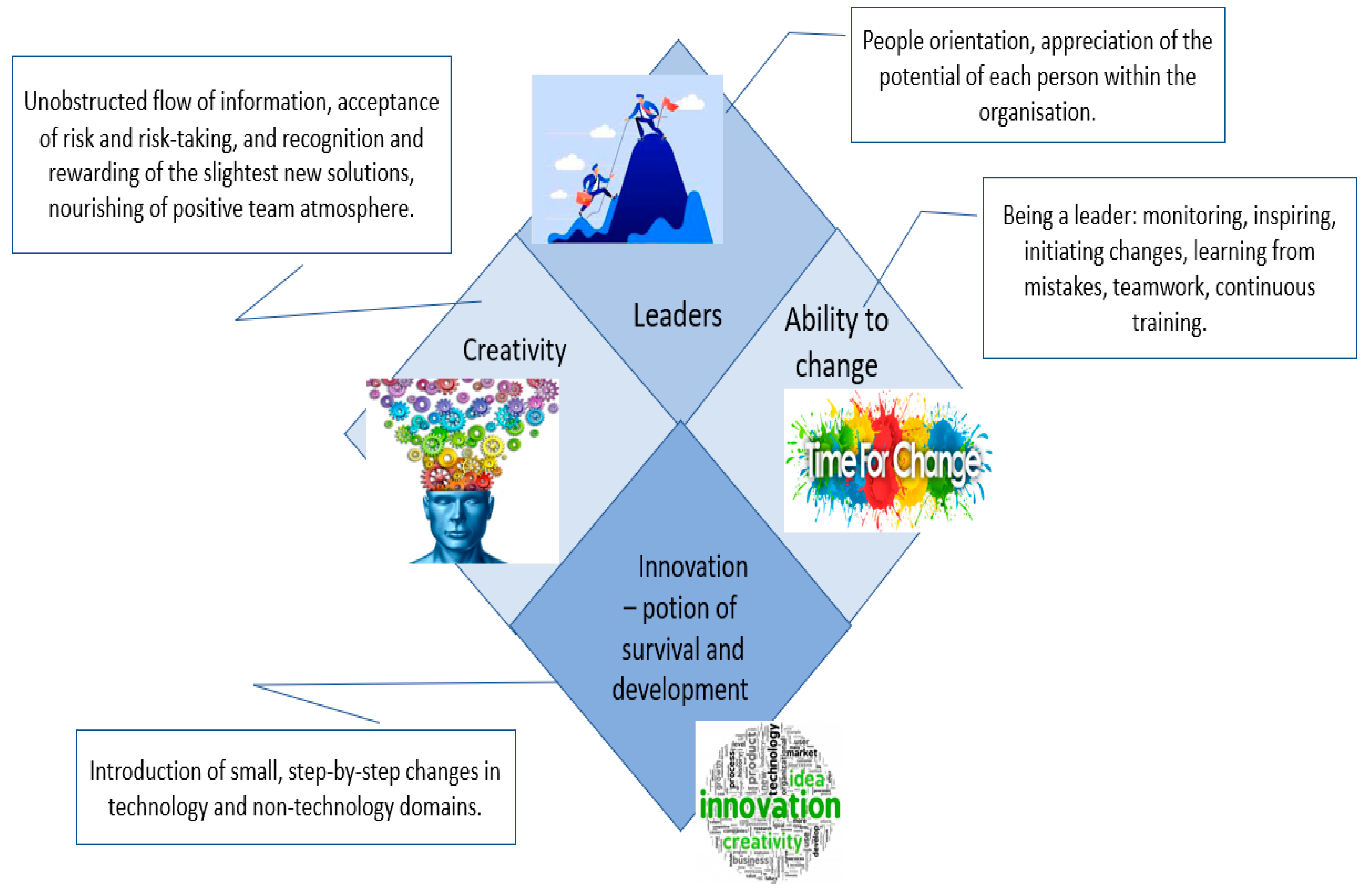
| Variables | Pearson’s Chi-Squared | p | Maximum Likelihood Chi-Squared | p | df |
|---|---|---|---|---|---|
| Crisis vs. enterprise size | 20.78789 | 0.00012 | 20.96982 | 0.00011 | 3 |
| Crisis vs. section | 29.40782 | 0.00012 | 29.92991 | 0.00010 | 7 |
| Yes | No | |
|---|---|---|
| Enterprise size | ||
| Micro (0–9 people) | 62.60% | 37.40% |
| Small (10–49 people) | 49% | 51% |
| Medium (50–249 people) | 38.70% | 61.3 |
| Large (over 250 people) | 42.7 | 57.3 |
| Column total: | 49.50% | 50.50% |
| Industries (sections) | ||
| C—manufacturing | 49.46% | 50.54% |
| F—construction | 38.46% | 61.54% |
| G—wholesale and retail trade | 49.30% | 50.70% |
| H—transport and storage | 64.44% | 35.56% |
| J—information and communication services | 60.19% | 39.81% |
| M—professional, scientific, and technical services | 34.07% | 65.93% |
| O—public administration | 28.95% | 71.05% |
| S—other services | 64.86% | 35.14% |
| Total | 49.52% | 50.48% |
| Pearson’s Chi-Squared | p | Maximum Likelihood Chi-Squared | p | df | |
|---|---|---|---|---|---|
| New products | 22.34753 | 0.03380 | 22.09635 | 0.03645 | 12 |
| Improved products | 39.29739 | 0.00009 | 39.04751 | 0.000010 | 12 |
| New production process solutions | 50.11906 | 0.00000 | 49.59923 | 0.00000 | 12 |
| New packaging | 19.43895 | 0.07847 | 20.45483 | 0.05896 | 12 |
| New sale channels (e.g., online) | 13.72934 | 0.31833 | 13.40207 | 0.34051 | 12 |
| New pricing policy | 18.02392 | 0.11497 | 18.51334 | 0.10097 | 12 |
| Planning | 37.79458 | 0.00017 | 37.82298 | 0.00016 | 12 |
| Organising | 52.83097 | 0.00000 | 52.10566 | 0.00000 | 12 |
| Leadership (motivating, leading) | 52.83097 | 0.00000 | 52.10566 | 0.00000 | 12 |
| Control | 55.23910 | 0.00000 | 54.58167 | 0.00000 | 12 |
| Pearson’s Chi-Squared | p | Maximum Likelihood Chi-Squared | p | df | |
|---|---|---|---|---|---|
| New products | 44.57253 | 0.02436 | 49.40257 | 0.00753 | 28 |
| Improved products | 40.59601 | 0.05846 | 46.00449 | 0.01741 | 28 |
| New process solutions | 31.69638 | 0.28704 | 36.44088 | 0.13171 | 28 |
| New packaging | 62.18367 | 0.00021 | 70.63944 | 0.00002 | 28 |
| New sale channels (e.g., online) | 54.46790 | 0.00197 | 60.51265 | 0.00035 | 28 |
| New pricing policy | 56.05525 | 0.00127 | 61.77072 | 0.00024 | 28 |
| Planning | 32.50338 | 0.25451 | 32.94326 | 0.23784 | 28 |
| Organising | 24.47934 | 0.65600 | 25.47430 | 0.60192 | 28 |
| Leadership (motivating, leading) | 33.66772 | 0.21203 | 34.25059 | 0.19274 | 28 |
| Control | 36.65005 | 0.12678 | 35.92897 | 0.14442 | 28 |
| Means Tested against a Reference Value. Threshold Condition v9 = ’yes’. | ||||||||
|---|---|---|---|---|---|---|---|---|
| Mean | SD | Valid | SE | Reference | t | df | p | |
| H: 1 | 2.8 | 1.15 | 308 | 0.07 | 3.00 | –2.270 | 307 | 0.0239 |
| H: 2 | 2.7 | 1.11 | 308 | 0.06 | 3.00 | –5.062 | 307 | 0.0000 |
| H: 3 | 3.2 | 0.81 | 308 | 0.05 | 3.00 | 3.916 | 307 | 0.0001 |
| H: 4 | 3.2 | 1.26 | 308 | 0.07 | 3.00 | 3.300 | 307 | 0.0011 |
| H: 5 | 3.1 | 1.21 | 308 | 0.07 | 3.00 | 1.985 | 307 | 0.0480 |
| H: 6 | 3.3 | 0.76 | 308 | 0.04 | 3.00 | 6.503 | 307 | 0.0000 |
| Variable | Group 1: no (Crisis-Free); Group 2 Yes (Affected by Crisis) | ||||
|---|---|---|---|---|---|
| Mean for Group 1 no | Mean for Group 2 yes | t | df | p | |
| New products | 2.93 | 2.85 | 0.900 | 620 | 0.3682 |
| Improved products | 2.81 | 2.72 | 1.069 | 620 | 0.2855 |
| New process solutions | 2.68 | 2.68 | –0.002 | 620 | 0.9980 |
| New packaging | 2.07 | 2.28 | –2.542 | 620 | 0.0113 |
| New sale channels (e.g., online) | 2.69 | 2.92 | –2.187 | 620 | 0.0291 |
| New pricing policy | 2.55 | 3.01 | –5.013 | 620 | 0.0000 |
| Organisational structure changes | 2.71 | 3.24 | –5.429 | 620 | 0.0000 |
| Planning | 3.32 | 3.48 | –1.824 | 620 | 0.0686 |
| Organising | 3.58 | 3.63 | –0.569 | 620 | 0.5697 |
| Leadership (motivating, leading) | 2.98 | 3.14 | –1.688 | 620 | 0.0920 |
| Control | 2.98 | 3.22 | –2.727 | 620 | 0.0066 |
| Social media | 2.90 | 3.18 | –4.148 | 620 | 0.0000 |
| Significant remote work | 3.07 | 2.94 | 1.839 | 620 | 0.0663 |
| New messengers and communication platforms | 3.19 | 3.08 | 1.512 | 620 | 0.1311 |
| New solutions vs. enterprise’s innovativeness | 3.39 | 3.28 | 1.852 | 620 | 0.0646 |
Publisher’s Note: MDPI stays neutral with regard to jurisdictional claims in published maps and institutional affiliations. |
© 2021 by the author. Licensee MDPI, Basel, Switzerland. This article is an open access article distributed under the terms and conditions of the Creative Commons Attribution (CC BY) license (https://creativecommons.org/licenses/by/4.0/).
Share and Cite
Gorzelany-Dziadkowiec, M. COVID-19: Business Innovation Challenges. Sustainability 2021, 13, 11439. https://doi.org/10.3390/su132011439
Gorzelany-Dziadkowiec M. COVID-19: Business Innovation Challenges. Sustainability. 2021; 13(20):11439. https://doi.org/10.3390/su132011439
Chicago/Turabian StyleGorzelany-Dziadkowiec, Magdalena. 2021. "COVID-19: Business Innovation Challenges" Sustainability 13, no. 20: 11439. https://doi.org/10.3390/su132011439
APA StyleGorzelany-Dziadkowiec, M. (2021). COVID-19: Business Innovation Challenges. Sustainability, 13(20), 11439. https://doi.org/10.3390/su132011439






